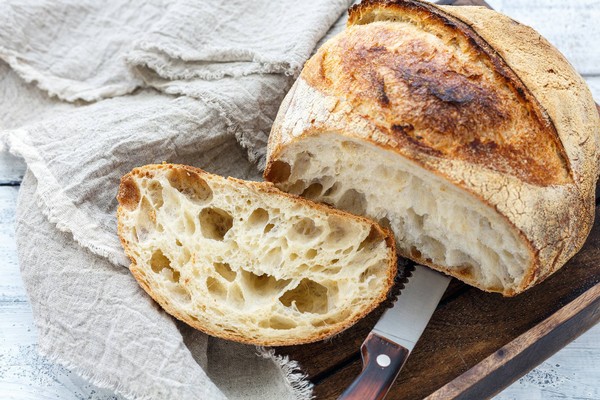No knead Sourdough Bread

This my go-to Sourdough bread recipe. It's relatively simple and does not require any kneading.
Marthinus StrydomThe Story
There are many, many ways to make a loaf of Sourdough bread. So many methods and techniques, so much conflicting advice online in blogs, books, videos, it's really quite overwhelming and put me off making sourdough for ages.
The truth is that with knowledge of the principle of yeasted bread making, and an understanding of how sourdough bread works, when you actually come to make a loaf you realise how simple it is and really how flexible the process is. In many ways it’s the trickiest bread to make and in many ways the simplest.

Subscripe to my Facebook page.
Subscripe to my Youtube channel.
© All recipes are copyright protected by TheCultureCook.com unless the recipe was adapated from another source. All recipes are uniquely crafted and adapted by TheCultureCook.com. Copyright of some or all of the text reside with the original author.
Ingredients
Method
- Day 1 - Feed your starter
- Day 2 - Take the required amount of your starter out of the pot and put in in a large bowl, put your scraping pot (leftover starter) in the fridge for next time. Add the water flour and salt and mix it together into a dough with your dough scraper. Mix for a minute or so to make sure everything is combined. Let this mixture rest and soak for 30 minutes. REST 30 MIN
- First Fold: Spray the work surface with water, and the top of your dough. Turn the dough out onto the wet surface upside down. Work around the dough pinching a piece with your finger and thumb, stretching it out and folding it back over the dough making a ball. 12 folds should be enough. Roll the dough back over, smooth side up, return it to the bowl, cover with a clean cloth and leave to rest for 2 hours. You can also stretch and fold the dough inside the container without taking the dough out. REST 2 HOURS
- Second Fold: After the dough has rested it should have puffed up slightly. Spray the table and dough again with water. Turn the dough out and reshape into a ball. 6 stretches and folds should be enough this time, roll the dough over with the smooth side on top and tuck everything underneath with your hands. Return the dough to the bowl for a further 2 hours. REST 2 HOURS
- Third Fold: After the dough has rested for this second time there should be clear signs of the dough rising, Stretch and fold the dough once more exactly like the last time, and return the dough to the bowl to rest for 1 hour. REST 1 HOUR
- Pre-shape: This time after resting it’s time to pre-shape the dough. Dust your surface with flour, turn out your dough upside down onto the surface. If you have doubled the recipe to make two loaves, divide it into two at this point with the flat side of your dough scraper. Shape the dough into a ball really quite tight without tearing it. Rest on the counter for 20 min (if room temp is higher than 28c) or 1 hour (if room temp is lower than 20c). Do not cover. We want the skin of the dough to dry out a little. REST 30 MIN - 1 HOUR
- Final Shape: In the final shaping the aim is to create a tight structure without degassing the dough too much. So be delicate with the folds but still creating tension. Dust your work surface with a little flour, slide your dough scraper underneath and turn the dough upside down onto a lightly dusted surface. Let it relax into a circle. Pick up the side edges one by one, stretching out very slightly and folding over the dough, one over the top of the other. Roll the dough from the top edge towards you into a sausage and stick it onto the sticky patch closest to you, pinching the seam to stick in place. When you are done, dust it well with rice flour, and dust an oval banneton basket with rice flour. Place the dough in the basket upside down (seam side up). If you don’t have a basket, line a colander or bowl with a cloth and dust it well. I prefer to line the basket with parchment paper. It prevents sticking and it's easier to take out the following day.
- Final Rest: At this stage rest your dough in the fridge covered with a shower cap or plastic bag to prove nice and slowly overnight. REST OVERNIGHT
- Day 3 - Baking your loaf: When you are ready to bake, preheat the oven. Do not remove the dough from the oven until you are ready to bake. Preheat the oven to 230°C fan/456°F/gas mark 8 with a dutch oven inside. SEE NOTE BLOW FOR STEAM OVEN INSTRUCTIONS
- Before removing from the banneton, gently stitch the dough to make the dough tighter. Do this before you flip the banneton onto a parchment paper. This is very important. You don't want your dough to collapse.
- Turn out the loaf onto floured baking paper and slide it into the dutch oven.
- Bake for 10 min in the dutch oven with the lid on then remove. Quickly score the bread length ways. Cut deep. Then cut at and angle under the skin of the loaf on both sides of the original cut. You are trying to cut the crust away from the inside in order to develop the "ear" of the bread. Do this quick and get the bread back into the oven. BAKE 10 MIN (score)
- Bake for 10 minutes with the lid on. BAKE 10 MIN
- Remove the lid and bake for another 20 minutes. BAKE 20 MIN
- Allow to cool completely on a wire rack before slicing. COOL 1 HOUR
NOTE FOR STEAM OVENS:
NB: This is for an open bake on a baking sheet or baking stone. Not using a dutch oven
- Preheat : 260c (fan speed 1)
- 5 Min at 220c, fan speed 1 and 80% steam. (take out and score)
- 13 Min at 220c, fan speed 1 and 80% steam.
- 18 Min at 220c, fan speed 2 and 0% steam. Remove and test doneness by tapping the bottom of the bread. If it sounds hollow, it's ready. If not, put it back for a few more minutes.
